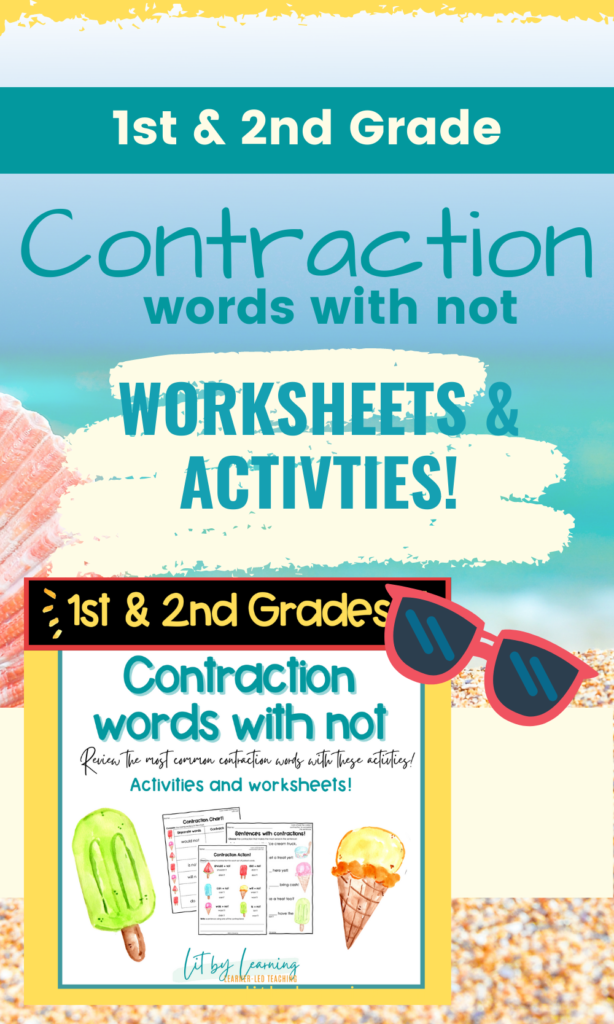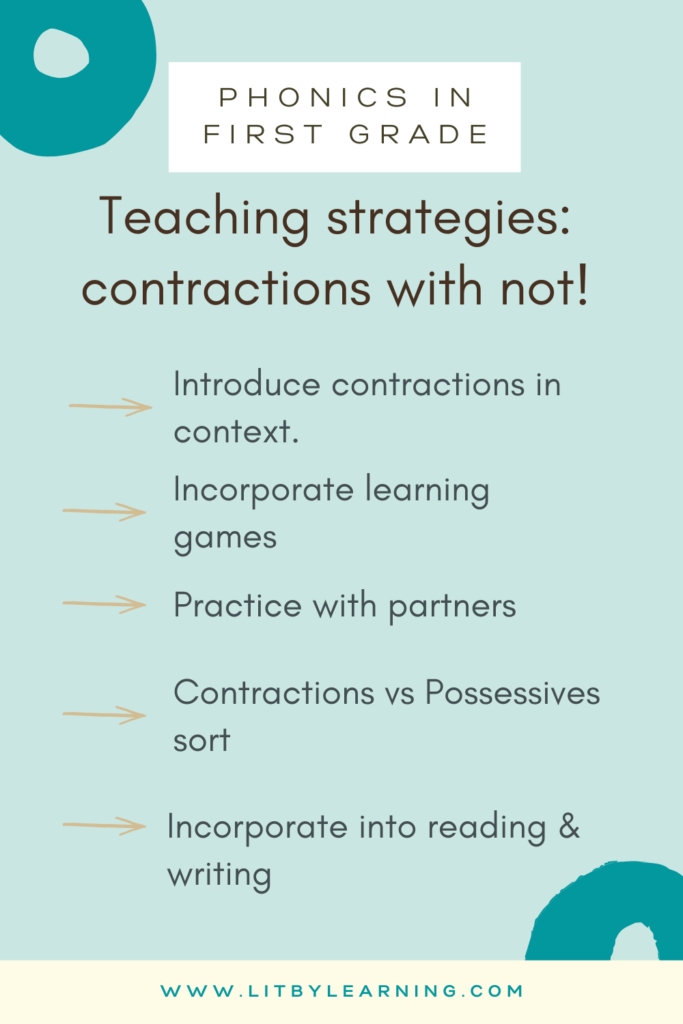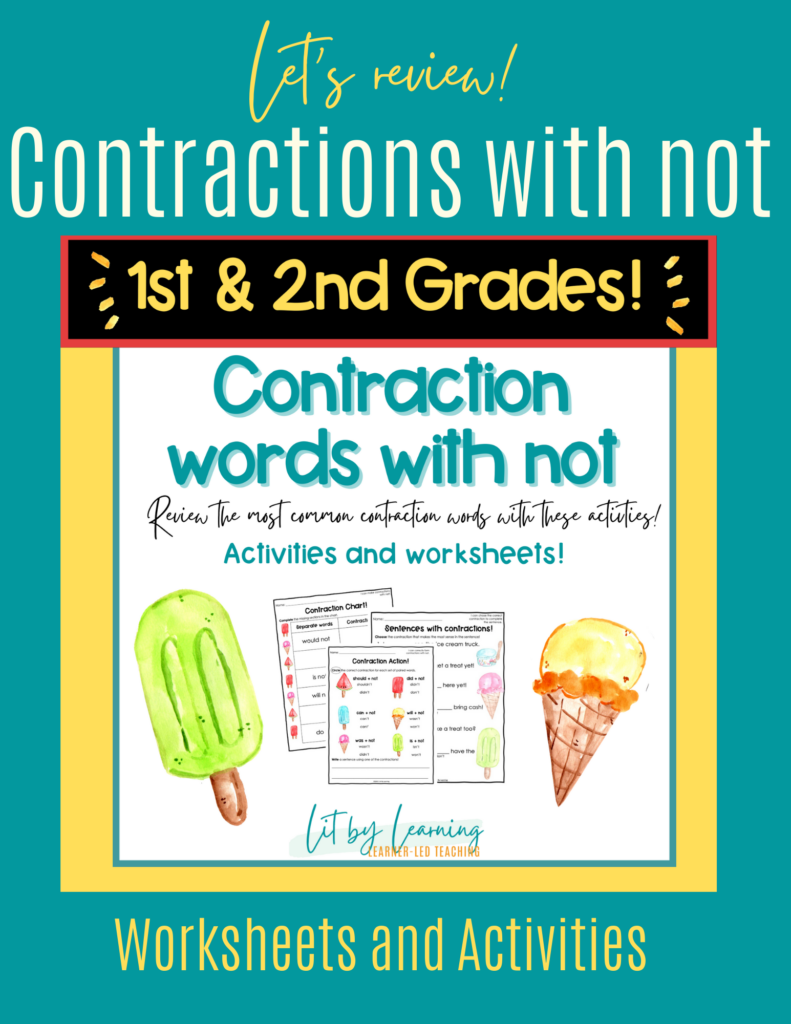Help your elementary students understand contractions words with these five simple teaching strategies. Your students will be reading and writing contractions like pros in no time!

Why teach contractions words?
Contractions are a fundamental part of the English language, but they can be tricky for young learners to grasp. Elementary teachers teach contractions words so that students can decode and encode words with meaning. Instruction in contraction words is also standards based!
CC.2.L.2.c Conventions of Standard English: Use an apostrophe to form contractions and frequently occurring possessives.
Although this is a second grade standard, 1st grade students who are reading at grade level will need to decode and comprehend contraction words to access on-level texts. For example, if a student read “The kid wouldn’t go into the cave,” they would need to know that wouldn’t is would+not to understand that the kid would not enter the cave.
Fortunately, there are several effective teaching strategies that can help your students understand and use contractions with ease. From hands-on activities to interactive games, these tips will have your students contracting like pros in no time!
Introduce contractions in context.
When teaching contractions to first graders, it’s important to introduce them in context. This means showing students how contractions are used in everyday language and providing examples of contractions in sentences. For example, you could use a sentence like “I am going to the store” and show how it can be contracted to “I’m going to the store”. This helps students understand the purpose and meaning behind contractions, making it easier for them to use them correctly in their own writing and speech. Doing a scavenger for contractions words will help students develop an eye for them in the texts they’re already reading!

Play games to make learning fun.
One of the best ways to teach contractions to first graders is through games. As all elementary teachers know, games make learning fun and engaging, and can help students remember the material better. For example, you could play a matching game where students match the contracted form of a word with its full form. Or, develop a simple board game that requires students to combine the separate words into a contraction before progressing to the next space. By integrating games into your lesson plans, you can make learning about contractions a fun and memorable experience for your first graders.

Practice with partner activities.
Partner activities are a great way to help first graders practice using contractions in a fun and interactive way. One activity you could try is having students work in pairs to create sentences using contractions. For example, one student could say “I am going to the store” and the other student could respond with “I’m going to the store too!” This not only helps students practice using contractions, but also encourages communication and collaboration skills. Another activity could be a “contraction race” where students race to see who can write the most contractions correctly in a set amount of time. These partner activities can make learning about contractions more engaging and enjoyable for your first graders.
Sort: Contractions vs. possessives
Address one of the most common misconceptions in learning contraction words with a simple sort! Using either solo words or short phrases, challenge students to determine when a word with an apostrophe is being used as a contraction vs. a possessive. As a next step, push students to write their own sentences using a mix of both contractions and possessives.
For example, a student might write: Kate’s hat won’t fit in the box. In this sentence, Kate’s is a possessive and won’t is a contraction.
Incorporating contractions words in reading and writing
You introduced contractions in context; now challenge students to apply their knowledge back in context! Students can read contractions by themselves, within short phrases or fluency sentences, and – eventually – in a reading passage. Reading aloud with help students with their contraction word pronunciation. Asking text-dendepent questions that necessitate understanding of the contaction will further challenge your students to master this skill. For example, if a passage reads: “Jack didn’t know how to swim. He couldn’t get to the raft.” you may ask, “Is Jack a good swimmer?”
Next, encourage elementary students to incorporate contractions into their own writing. Observe how students use their new knowledge: Are they spelling contraction words correctly? Do they make sense in the sentences?

Read more!
Interested in reading more from Kate at LIt By Learning? Check out these other elementary literacy-focused posts!
- Explicit vocabulary instruction: 5 genius activities for ELL students: Read about the strategies I use to teach vocabulary to my ELL students (really, ALL my students!)
- Summer writing prompts for fun for elementary kids: Inspire your students to keep writing over the summer with these fun writing prompts!
- How do you effectively teach first graders elements to a story? Gather some ideas in the post about teaching story elements like characters and setting to elementary students!


